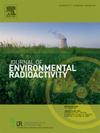Measurements of the natural background of radioxenon isotopes in soil gas
IF 2.1
3区 环境科学与生态学
Q3 ENVIRONMENTAL SCIENCES
引用次数: 0
Abstract
Radioisotopes of xenon are used as indicators for an underground nuclear explosion (UNE), and it is essential to be able to distinguish a potential signal from an UNE from the natural background, i.e. from spontaneous fission of uranium. The natural occurring background of radioxenon isotopes have been studied in Sweden in three separate campaigns in the period 2019–2022. In total more than 100 samples were collected and analysed for radioxenon and especially 133Xe was detected in most of the samples. This gives a good data set for understanding of the natural background of xenon in the soil. The extended sampling was performed with the goal to study any potential trend with different weather conditions, e.g. ambient pressure and rainfall, and during different seasons. The sampling method and logistics were optimized over the years to improve the sensitivity of the most short-lived isotope in this study, 135Xe. One method was to shorten the time between collection and measurement which lead to the first detections of 135Xe in the natural background of soil gas.
土壤气体中放射性氙同位素自然本底的测量
氙的放射性同位素被用作地下核爆炸的指示器,能够从自然背景,即铀的自发裂变中区分地下核爆炸的潜在信号是至关重要的。瑞典在2019-2022年期间的三个独立活动中研究了放射性氙同位素的自然发生背景。共采集了100多个样品进行了放射性氙分析,其中大部分样品中检测到133Xe。这为了解土壤中氙的自然背景提供了一个很好的数据集。进行扩展采样的目的是研究不同天气条件下的潜在趋势,例如环境压力和降雨,以及不同季节。多年来,为了提高本研究中寿命最长的同位素135Xe的灵敏度,我们对采样方法和物流进行了优化。一种方法是缩短收集和测量之间的时间,从而在土壤气体的自然背景中首次检测到135Xe。
本文章由计算机程序翻译,如有差异,请以英文原文为准。
求助全文
约1分钟内获得全文
求助全文
来源期刊

Journal of environmental radioactivity
环境科学-环境科学
CiteScore
4.70
自引率
13.00%
发文量
209
审稿时长
73 days
期刊介绍:
The Journal of Environmental Radioactivity provides a coherent international forum for publication of original research or review papers on any aspect of the occurrence of radioactivity in natural systems.
Relevant subject areas range from applications of environmental radionuclides as mechanistic or timescale tracers of natural processes to assessments of the radioecological or radiological effects of ambient radioactivity. Papers deal with naturally occurring nuclides or with those created and released by man through nuclear weapons manufacture and testing, energy production, fuel-cycle technology, etc. Reports on radioactivity in the oceans, sediments, rivers, lakes, groundwaters, soils, atmosphere and all divisions of the biosphere are welcomed, but these should not simply be of a monitoring nature unless the data are particularly innovative.
 求助内容:
求助内容: 应助结果提醒方式:
应助结果提醒方式:


